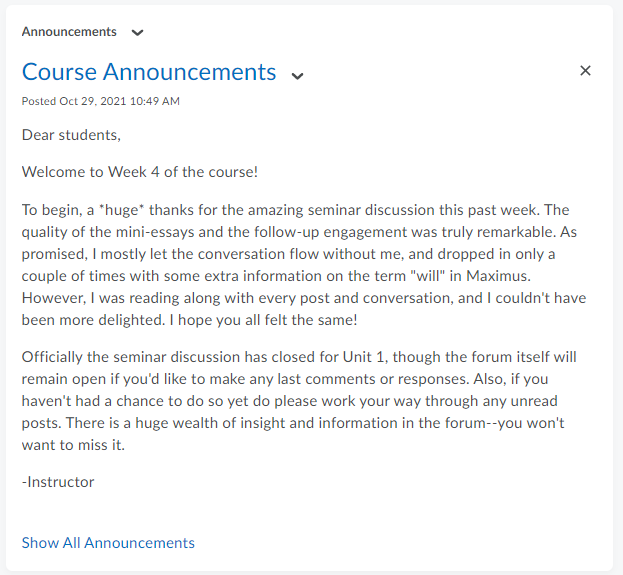Module 3: Facilitating for connection
3.3 Encouraging learner–learner interactions during term
Key principles: Fostering social spaces in online courses

Encouraging learner–learner interaction, and creating social spaces in your online courses begins at the level of design. Making sure that your learners will have opportunities to engage with one another in a variety of ways is the most important step you can take to creating social presence in your course. We have covered some of the most important design considerations for social presence in your course in a previous module.
Whether or not you designed your course, however, there are a few things you’ll want to keep in mind about learner-learner interaction and social presence while you are teaching during term.
Discussion forums are like dinner parties, and the instructor is the host. Personally welcoming each student into this new and unfamiliar place and making them feel like they belong in that environment is a necessity to help integrate them socially and academically into the course.
(Hayek, 2012)
As with every aspect of online design and teaching, signalling your presence in the social spaces of your course is crucial for fostering deeper learner-learner interaction and thus humanizing the online course experience for everyone. While social spaces are typically not where most course content is shared in online courses, you still play a crucial role in helping learners to feel welcome and encouraged to participate in every aspect of your online course. Thinking of yourself as a host, as in the quotation above, can be helpful for framing your role in encouraging learner-learner interaction during term.

Your presence and investment in learner-learner interactions can be signalled in a variety of ways. Just a few examples include
- facilitating discussions actively by sharing prompts and questions as the term progresses;
- actively posting in discussions and other forums throughout the term (see the next section for more on how much and how often to post);
- summarizing key discussions after the fact, whether inside the discussion itself or through an announcement or other message;
- participating in social spaces in your online course, such as general chat forums or course-related social media threads; and
- checking in on learner interactions, especially group work, to make sure things are going smoothly and to help with any problems that arise.
Giving the right sense of presence in your online course helps humanize the learning environment by modelling the kinds of interactions you would like to see between learners, and by setting the tone to create comfortable and active spaces for learners to interact.
Balancing your involvement
How much should you post to discussions and participate in other learner–learner interaction spaces in your course? As with so many things the answer is seldom simple, and effective presence in social spaces involves striking the right balance given your learner population, the nature of your course, and your own teaching style.
Instructors should jump in quickly when they see [a] discussion in the thread is wrong or getting well off track; otherwise hold back for the first week and let the learners have at it. Coming in too early with comments tends to shut down the discussion.
(Mazzolini & Maddison, 2007)
On the one hand, research shows that more frequent posting by instructors in course discussions is correlated to less frequent posting on the part of learners (Mazzolini & Maddison, 2007) which may in part be caused by learners feeling they have less to add to certain conversations after the instructor’s opinions have been shared.
On the other hand, sheer frequency of posting may not be the only thing to consider regarding the overall impact of various interactions in your course (Mazzolini & Maddison, 2007). For instance,
- sharing accurate information and clearing up learners’ confusion as an instructor has obvious positive impacts on learning even if doing so results in less follow-up discussion, and
- instructors who post frequently are rated by learners as more enthusiastic and as displaying greater subject matter expertise (Mazzolini & Maddison, 2007).
Such perceptions on the part of learners can be useful in creating instructor presence in your course. In short, posting too much can stifle conversation in online classes, while posting too little may make you seem distant and may allow learner errors to go uncorrected.
As you navigate the tightrope act of how much to involve yourself in discussions and similar spaces, consider the purpose of a particular interaction or assessments as well as where you are in the natural life cycle of learner–learner interactions. For discussions that are meant to encourage learners to get to know one another, as well as those that are more seminar or opinion-based, you may wish to have a lighter touch with respect to your immediate presence. For discussions that focus more on learning content, especially fact-based materials, it may be worth weighing in more often to keep learners on the right track even if they post less frequently afterward.
Strategies in action: Signaling presence in learner–learner interactions
Here is a real world excerpt from a course announcement signalling the instructor’s interest in a previous week’s forum discussion.

Key principles: Facing challenges in learner–learner interactions
In the next module, we will discuss some of the EDDI-related problems that can arise between learners in online courses. Here, we will talk briefly about some more everyday social challenges that crop up with some frequency in online courses.
Conflict and poor netiquette
Conflict and disagreement are natural in academic discussions and are not necessarily a problem in online courses when navigated carefully by all parties. However, when conflict heats up to the point that etiquette breaks down, or begins to monopolize a conversation, it can start to be a problem. Asynchronous discussions in particular can present challenges arising from transactional distance such that learners may read one another’s words less generously and with less of the human context than they would have when speaking in-person. When small signals like body language and tone of voice are not available, conflicts can escalate quickly.
One of the most important steps you can take to mitigate conflict in your online class is to make sure your expectations for how learners will treat one another in their discussions are extremely clear. Spell out for your learners what good online etiquette (sometimes called “netiquette”) entails and how you expect them to speak to one another especially when disagreeing. Consider making netiquette a component of learners’ participation or discussion marks to further encourage good discourse. If problems still arise during term consider taking some of the following steps:
- contact the individual learners involved and reminding them of your expectations and requirements;
- remind the class as a whole, in general terms, of your netiquette policies. Never call out specific learners for violations of these policies in public, however;
- intervene in a discussion where possible to mediate potential conflict, especially if you perceive a misunderstanding or failure of communication.
In addition, strive to humanize the environment around your course discussions by helping learners get to know each other. If possible, encourage or require learners to post photos of themselves and/or aspects of their lives like pets, family, homes and communities as much as they are comfortable. Be sure to spend some time breaking the ice at the beginning of your course. And when conflicts do arise, help draw learners back to the mutual recognition of one another as real people with feelings and values of their own. The more human an environment you can create, the less problematic conflict you are likely to encounter in online discussions.
Shallow responses and lack of engagement
Shallow responses and lack of engagement are a common problem in online course discussions. But humans learn best in communities where there is a high degree of energy and engagement with the learning materials. For this reason, encouraging vigorous participation from all learners is a great way to improve everyone’s online course experience.
Once again, the most important step to take to encourage participation is to be extremely clear about expectations for participation online. Basics like the number of posts required and how often learners need to engage are, of course, essential. Consider digging deeper and providing learners with further guidance about what makes an effective and engaging discussion (or other asynchronous) post by providing,
- clear rubrics, which help learners to know what you expect;
- detailed descriptions of what makes for good posting and engagement, and if possible
- examples of good posts that learners can emulate.
If certain learners nonetheless seem disengaged, are posting very little, and/or are only posting short responses like “I agree,” reach out to them to see how you can help them to more fully meet your expectations. A lack of participation can be a sign of many things, including a learner misunderstanding requirements, or a learner who has become more broadly disengaged for any number of reasons. With a little help, most learners can get back on track and be a full part of an online course community when they feel fully supported.
Going deeper
This guide to netiquette from Ontario Tech provides a deeper dive into the subject and some practical tips.
These articles from Faculty Focus discuss some ways you can respond to problem conflict in online courses.
Strategies in action: Facing challenges in learner–learner interactions
Clarity about your expectations for how learners will conduct themselves in forums and other discussions can go a long way to reducing problem conflict and other issues in your online course. Below is an example guide to netiquette shared in a real course. Feel free to adapt and reuse the guide yourself!
Credit: Daniel Opperwall, Trinity College, University of Toronto
References and credits
Hayek, C. (2012). How many faculty discussion posts each week? A simply delicious answer. Faculty Focus. https://www.facultyfocus.com/articles/online-education/online-course-design-and-preparation/how-many-faculty-discussion-posts-each-week-a-simply-delicious-answer/
Mazzolini, M. & Maddison, S. (2007) When to jump in: The role of the instructor in online discussion forums. Computers & Education 49(2), 193–213. https://doi.org/10.1016/j.compedu.2005.06.011

